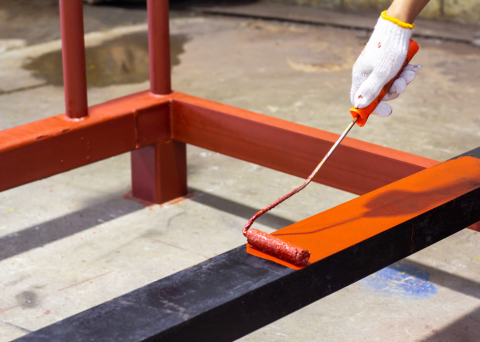
We talk a lot about the difference between water-based paint and oil-based paint. For almost any painting project you can use either, but each have their pros and cons. Both types are fantastic regardless of where you use them; often the ‘best’ option comes down to personal preference, budget, or a specific goal.
So instead of creating another written sparring match, today we’re going to keep things simple and tell you where you should use oil-based paint.
What is Oil-Based Paint?
Oil-based paint, as the name suggests, uses a compound that contains oil. This makes the paint naturally thicker and repels moisture more easily. This is why oil-based paints are most often used outside, where rain and standing water can eat away at an unprotected surface.
Why Choose Oil-Based Paint?
The main reason many decorators choose oil-based paint is because of its toughness. That oil-based compound repels moisture, like we said, but it is also more resistant to scratches and scuffs, making it ideal for high-wear areas.
By this we mean any surfaces that go through a lot. Skirting boards, for example, are almost always painted with oil-based paint as they get scuffed by shoes, hit when hoovering, and can be scratched by pets. Most exterior surfaces are ‘high wear’ too, as they’re exposed to the elements 24/7.
Another major advantage is that oil-based paint needs fewer layers on average. If you are a professional painter with a large space to cover, such as in industrial or commercial applications, you want to minimise your painting time. Most oil-based paints only need 1-2 layers, plus an initial layer of primer, so you need less paint overall.
However, one thing you should always keep in mind that the drying times for oil-based paint will be longer – don’t forget this when you’re putting time aside.
High-Sheen Oil-Based Paint
Another reason to choose an oil-based paint is its sheen level. Because of the oily compound, these paints are naturally glossier once dry. This is ideal in many cases; it contrasts matt painted surfaces well. If you’re looking for a gloss paint, it’s better to choose an oil-based paint as it will have the same look but with extra toughness that makes the sheen last longer.
On the other hand, if you aren’t a fan of high-sheen and the light it reflects, it’s best to stick to low-sheen paints instead. There are a few low-sheen oil-based paints, but these sometimes tricky to find. But we do have plenty available, browse our oil-based paints page to find the one that suits you.
Where should Oil-Based Paint be used?
The main place you should use an oil-based paint is outside. As we’ve said toughness is the biggest advantage of oil-based paints, so you want to use them on surfaces that suffer a lot of wear. Fences and outdoor furniture can all benefit from a few layers of oil-based paint.
Looking indoors, there are even more places you can use your oil-based paint. As well as skirting boards, oil-based paints are commonly used on trim such as door frames, windowsills, and furniture items. IKEA furniture especially looks great with a gloss finish, and our oil-based paints will keep each piece looking its best for a long time.
There are plenty of more niche applications for oil-based paints too. If you’re marking out areas in an industrial setting our oil-based lining paint is perfect for the job. There’s also our oil based satinwood paint, ideal for enhancing wooden surfaces. If not wood, why not stone? Our block paving sealer adds extra protection to driveways, paths, and patios.
Essentially, oil-based paints are best used on surfaces that you don’t intend to repaint any time soon. Surfaces that should only be painted every decade or so benefit from the extra durability of oil-based paints. Once you’ve ticked off your interior doors, furniture, skirting boards, garage door, and more, you can spend more time and budget on other surfaces like walls that you’re more likely to repaint in the near future.
Disadvantages of Oil-Based Paint
Although we’re more than happy to sing the praises of our oil-based paint, there are a few things you should keep in mind. As well as longer drying times, an oil-based paint can have a strong odour, and they aren’t always safe for children or pets. This is why we mostly recommend oil-based paint for commercial and industrial applications, as these are child-free and have better ventilation than the average home.
Despite the toughness of the compound, some oil-based paints will fade relatively quickly when exposed to direct sunlight. This is why they’re not always best for walls, but our oil-based paints are UV resistant, so they can handle years of constant light without fading.
Last but not least, oil-based paints aren’t the most beginner-friendly. For a domestic painter, shorter drying times and easier application may suit better, but for tradespeople with years of experience, you’ll have no trouble at all.
The UK’s Best Oil-Based Paint
No matter what you need to paint, we have an oil-based paint that will suit it perfectly. Whether you’re refreshing tired surfaces or adding an extra layer of protection, oil-based paints are the way to go. And with tins of all sizes and large barrels available, no job is too big or too small.
But if you still aren’t sure if they’re right for you, check out our range of oil-based paints to see if any catch your eye. Or you have read our other blogs for more advice and in-depth guides on how you can get the most out of your paint.
If you have any questions about any of our paints or painting accessories, please don’t hesitate to get in touch. We look forward to hearing from you.
